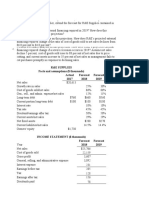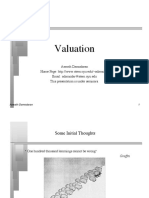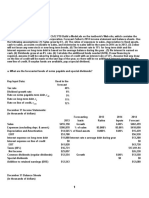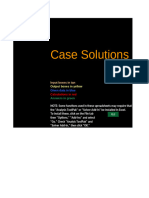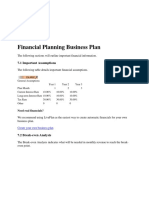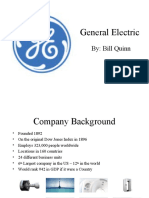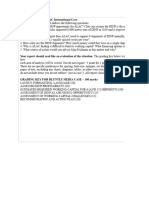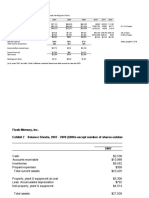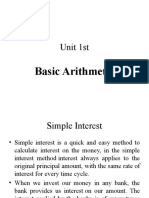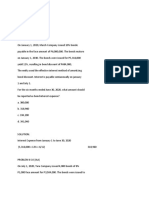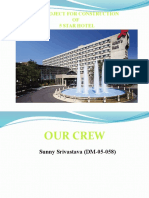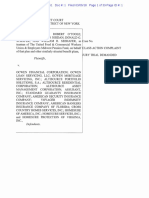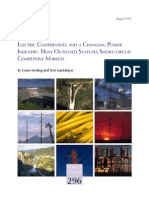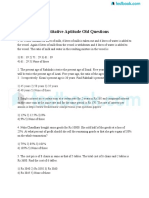Chapter 9. CH 09-10 Build A Model: Growth Sales
Chapter 9. CH 09-10 Build A Model: Growth Sales
Uploaded by
Matt SlowickCopyright:
Available Formats
Chapter 9. CH 09-10 Build A Model: Growth Sales
Chapter 9. CH 09-10 Build A Model: Growth Sales
Uploaded by
Matt SlowickOriginal Title
Copyright
Available Formats
Share this document
Did you find this document useful?
Is this content inappropriate?
Copyright:
Available Formats
Chapter 9. CH 09-10 Build A Model: Growth Sales
Chapter 9. CH 09-10 Build A Model: Growth Sales
Uploaded by
Matt SlowickCopyright:
Available Formats
Chapter 9.
Ch 09-10 Build a Model
Cumberland Industries' financial planners must forecast the company's financial results for the coming year. The forecast
for many items will be based on sales, and any additional funds needed will be obtained as notes payable.
a. Assuming the historical trend continues, what will sales be in 2010? Base your forecast on a spreadsheet regression
analysis of the 2004-2009 sales data above, and include the summary output of the regression in your answer. By what
percentage are sales predicted to increase in 2010 over 2009? Is the sales growth rate increasing or decreasing?
Here are the company's historical sales. Hint: Use the Trend function to forecast sales for 2010.
Year Sales Growth Rate
2004 129,215,000
2005 180,901,000 40.0%
2006 235,252,000 42.1%
2007 294,065,000 25.0%
2008 396,692,000 34.9%
2009 455,150,000 14.7%
2010 515,465,267 13.25%
% Increase in Predicted Sales for 2010 over 2009:
2009 Sales 455,150,000
2010 Sales 515,465,267
% increase 13.25% Note: This growth rate has been declining over time.
b. Cumberland’s management believes that the firm will actually experience a 20 percent increase in sales during 2010.
Construct 2010 pro forma financial statements. Cumberland will not issue any new stock or long-term bonds. Assume
Cumberland will carry forward its current amounts of short-term investments and notes payable, prior to calculating AFN.
Assume that any Additional Funds Needed (AFN) will be raised as notes payable (if AFN is negative, Cumberland will
purchase additional short-term investments). Use an interest rate of 9 percent for short-term debt (and for the interest
income on short-term investments) and a rate of 11 percent for long-term debt. No interest is earned on cash. Use the
beginning of year debt balances to calculate net interest expense. Assume that dividends grow at an 8 percent rate.
Key Input Data: Used in the
forecast
Tax rate 40%
Dividend growth rate 8%
S-T rd 9%
L-T rd 11%
growth sales 20%
December 31 Income Statements:
(in thousands of dollars)
Forecasting 2009 2010 2010
2009 basis Ratios Inputs Forecast
Sales $455,150 Growth 20.00% $477,908
Expenses (excluding depr. & amort.) $386,878 % of sales 85.00% 85.00% $406,221
EBITDA $68,273 $71,686
Depreciation and Amortization $7,388 % of fixed assets 11.00% 11.00% $7,757
EBIT $60,885 $63,929
Net Interest Expense $8,575 Interest rate x beginning of year debt $8,868
EBT $52,310 $55,061
Taxes (40%) $20,924 $22,024
Net Income $31,386 $33,037
Common dividends $12,554 Growth 8.00% $13,558
Addition to retained earnings (∆RE) $18,832 $19,478
Cumberland Industries December 31 Balance Sheets
(in thousands of dollars)
Forecasting 2009 2010 2010
2009 basis Ratios Inputs Without AFN AFN
Assets:
Cash and cash equivalents $91,450 % of sales 20.092% 20.092% $96,023
Short-term investments $11,400 Previous $11,400 $0
Accounts Receivable $103,365 % of sales 22.710% 22.710% $108,533
Inventories $38,444 % of sales 8.446% 8.446% $40,366
Total current assets $244,659 $256,322
Fixed assets $67,165 % of sales 14.757% 14.757% $70,523
Total assets $311,824 $326,845
Liabilities and equity
Accounts payable $30,761 % of sales $32,299
Accruals $30,477 % of sales $32,001
Notes payable $16,717 Previous $16,717 -$7,519
Total current liabilities $77,955 $81,017
Long-term debt $76,264 Previous $76,264
Total liabilities $154,219 $157,281
Common stock $100,000 Previous $100,000
Retained Earnings $57,605 Previous + ∆RE $77,083
Total common equity $157,605 $177,083
Total liabilities and equity $311,824 $334,364
Required assets = $326,845
Specified sources of financing = $334,364
Additional funds needed (AFN) = -$7,519
Required additional notes payable = $22,879
Additional short-term investments = $0
c. Now create a graph depicting the sensitivity of AFN for the coming year to the sales growth rate. To make
this graph, compare the AFN at sales growth rates of 5%, 10%, 15%, 20%, 25%, and 30%.
We can use a data table to answer this question:
Sales 2010 AFN
Growth rate -$7,519 $0
5% -$7,519 -$1,000
10% -$7,519
-$2,000
15% -$7,519
20% -$7,519 -$3,000
25% -$7,519 -$4,000 Column B
30% -$7,519
-$5,000
-$6,000
-$7,000
-$8,000
0% 5% 10% 15% 20% 25% 30% 35%
d. Calculate the Net Operating Working Capital (NOWC), Total Operating Capital, and NOPAT for 2009 and
2010. Also, calculate the FCF for 2010.
Net Operating Working Capital
NOWC09 = Operating CA - Operating CL
= $233,259 - $61,238
= $172,021
NOWC10 = Operating CA - Operating CL
= $244,922 - $64,300
= $180,622
Total Operating Capital
TOC09 = NOWC + Fixed assets
= $172,021 + $67,165
= $239,186
TOC10 = NOWC + Fixed assets
= $180,622 + $70,523
= $251,145
Net Operating Profit After Taxes
NOPAT09 = EBIT x (1-T)
= $60,885 x 60%
= $36,531
NOPAT10 = EBIT x (1-T)
= $63,929 x 60%
= $38,357
Free Cash Flow
FCF10 = NOPAT - Increase in TOC
= $38,357 - $11,959
= $26,398
e. Suppose Cumberland can reduce its inventory to sales ratio to 5 percent and its cost to sales ratio to 83 percent. What
happens to AFN and FCF?
Input Base Case New Scenario
Inv. / Sales 8.446% 5.0% Note: we used the Scenario Manager.
Costs / Sales 85.0% 83.0%
FCF $26,398
AFN $22,879
Scenario Summary
Current Values: Base New
Changing Cells:
$G$55 85.00% 85.00% 83.00%
$F$76 8.446% 8.446% 5.000%
Result Cells:
$B$157 -$4,000 -$4,000 $21,378
$G$95 $22,879 $22,879 -$2,499
Notes: Current Values column represents values of changing cells at
time Scenario Summary Report was created. Changing cells for each
scenario are highlighted in gray.
You might also like
- CFI - FMVA Practice Exam Case Study ADocument18 pagesCFI - FMVA Practice Exam Case Study AWerfelli MaramNo ratings yet
- CFI FMVA Final Assessment Case Study 1ADocument12 pagesCFI FMVA Final Assessment Case Study 1Apadre pio kone100% (1)
- Chapter 3 Problem 9: R&E Supplies Facts and Assumptions ($ Thousands) Actual Forecast Forecast 2017 2018 2019Document5 pagesChapter 3 Problem 9: R&E Supplies Facts and Assumptions ($ Thousands) Actual Forecast Forecast 2017 2018 2019阮幸碧No ratings yet
- Flash Memory Case SolutionDocument10 pagesFlash Memory Case SolutionsahilkuNo ratings yet
- Chapter 09. Solution For CH 09-10 Build A Model: AssetsDocument4 pagesChapter 09. Solution For CH 09-10 Build A Model: AssetsDiana SorianoNo ratings yet
- Mini CaseDocument7 pagesMini CaseHarrisha Arumugam0% (1)
- Sunset Boards Case StudyDocument3 pagesSunset Boards Case StudyMeredith Wilkinson Ramirez100% (2)
- Valuation - Aswath Damodaran PDFDocument109 pagesValuation - Aswath Damodaran PDF924957100% (1)
- Ch02 P14 Build A Model SolutionDocument6 pagesCh02 P14 Build A Model SolutionSeee OoonNo ratings yet
- FINC 721 Project 2Document2 pagesFINC 721 Project 2Sameer BhattaraiNo ratings yet
- Chapter 09. Student CH 09-10 Build A Model: AssetsDocument4 pagesChapter 09. Student CH 09-10 Build A Model: Assetsseth litchfieldNo ratings yet
- Financial Management - Brigham Chapter 3Document4 pagesFinancial Management - Brigham Chapter 3Fazli AleemNo ratings yet
- FCF 12th Edition Case SolutionsDocument66 pagesFCF 12th Edition Case SolutionsDavid ChungNo ratings yet
- Browning Ch03 P15 Build A ModelDocument3 pagesBrowning Ch03 P15 Build A ModelAdam0% (1)
- SAP MM Interview Questions and Answers For ExperiencedDocument37 pagesSAP MM Interview Questions and Answers For ExperiencedpunamNo ratings yet
- Chapter 7. Student CH 7-14 Build A Model: AssetsDocument5 pagesChapter 7. Student CH 7-14 Build A Model: Assetsseth litchfieldNo ratings yet
- Chapter 3. CH 03-10 Build A Model: AssetsDocument4 pagesChapter 3. CH 03-10 Build A Model: AssetsAngel L Rolon TorresNo ratings yet
- Assignment#01Document8 pagesAssignment#01Aaisha AnsariNo ratings yet
- Ch02-20 ModDocument4 pagesCh02-20 ModDaniel BalchaNo ratings yet
- Assignment SalmanDocument9 pagesAssignment SalmanSalman AtherNo ratings yet
- Assignement 5Document4 pagesAssignement 5Valentin Florin Drezaliu100% (1)
- 2 .Accounting Statements, Taxes, and Cash FlowDocument27 pages2 .Accounting Statements, Taxes, and Cash FlowBussines LearnNo ratings yet
- 386145Document10 pages386145UROOSA KHANNo ratings yet
- Financial PlanDocument12 pagesFinancial PlanNico BoialterNo ratings yet
- 3 Problem: 15: Joshua & White Technologies: December 31 Balance SheetsDocument3 pages3 Problem: 15: Joshua & White Technologies: December 31 Balance SheetsQudsiya KalhoroNo ratings yet
- Chapter 7. Student CH 07-15 Build A Model: AssetsDocument3 pagesChapter 7. Student CH 07-15 Build A Model: Assetsseth litchfieldNo ratings yet
- Laiho Industries Case-Financial Statements (2) 2Document1 pageLaiho Industries Case-Financial Statements (2) 2CSJNo ratings yet
- CH - 04 SolutionDocument3 pagesCH - 04 SolutionSaifur R. SabbirNo ratings yet
- Upload ExcelDocument6 pagesUpload ExcelJerry RodNo ratings yet
- Accounting Statements, Taxes, and Cash FlowDocument29 pagesAccounting Statements, Taxes, and Cash FlowBussines LearnNo ratings yet
- WA12Document2 pagesWA12IzzahIkramIllahiNo ratings yet
- IFM11 Solution To Ch08 P15 Build A ModelDocument2 pagesIFM11 Solution To Ch08 P15 Build A ModelDiana Soriano50% (2)
- Assets: Café Richard Balance Sheet As at 31 December 2019 & 2020Document3 pagesAssets: Café Richard Balance Sheet As at 31 December 2019 & 2020Jannatul Ferdousi PrïtyNo ratings yet
- Ross Fundamentals of Corporate Finance 13e Case SolutionsDocument66 pagesRoss Fundamentals of Corporate Finance 13e Case SolutionsFitri SafiraNo ratings yet
- HW 2 - Ch03 P15 Build A Model - HrncarDocument2 pagesHW 2 - Ch03 P15 Build A Model - HrncarsusikralovaNo ratings yet
- All Chapter Download Solution Manual For Financial Management Theory and Practice Brigham Ehrhardt 13th EditionDocument38 pagesAll Chapter Download Solution Manual For Financial Management Theory and Practice Brigham Ehrhardt 13th EditionnjokefonorNo ratings yet
- Finance ProblemsDocument50 pagesFinance ProblemsRandallroyce0% (1)
- Financial Plan: 7.1 Break-Even AnalysisDocument41 pagesFinancial Plan: 7.1 Break-Even AnalysisnahidasumbalsundasNo ratings yet
- Financial ManagementDocument12 pagesFinancial ManagementValeria MartinezNo ratings yet
- Business Financial AnalysisDocument14 pagesBusiness Financial Analysismc limNo ratings yet
- Financial Forecast, AFNDocument3 pagesFinancial Forecast, AFNayesha akhtarNo ratings yet
- Exercises AllDocument9 pagesExercises AllLede Ann Calipus YapNo ratings yet
- Financial Planning Business Plan: 7.1 Important AssumptionsDocument32 pagesFinancial Planning Business Plan: 7.1 Important AssumptionstemesgenNo ratings yet
- Ch02 P21 Build A ModelDocument3 pagesCh02 P21 Build A ModelFelipe WeulerNo ratings yet
- Finance Final Pitch General ElectricDocument8 pagesFinance Final Pitch General Electricbquinn08No ratings yet
- A. Calculate Watkins's Value of OperationsDocument20 pagesA. Calculate Watkins's Value of OperationsNarmeen Khan100% (1)
- Verizon Communications Inc.: Horizontal AnalysisDocument42 pagesVerizon Communications Inc.: Horizontal Analysisjm gonzalezNo ratings yet
- Problem 2-14 & 2-15Document12 pagesProblem 2-14 & 2-15Qudsiya KalhoroNo ratings yet
- Property, Plant, and Equipment Accumulated Depreciation Net Property, Plant, and EquipmentDocument6 pagesProperty, Plant, and Equipment Accumulated Depreciation Net Property, Plant, and EquipmentEman KhalilNo ratings yet
- CH 13Document14 pagesCH 13Trang VânNo ratings yet
- Chapter 8. Student Ch08 P 8-15 Build A Model: AssetsDocument2 pagesChapter 8. Student Ch08 P 8-15 Build A Model: Assetsseth litchfield100% (1)
- ALACDocument18 pagesALACshruthisreehkNo ratings yet
- Financial Planning and Forecasting: AsssumptionsDocument4 pagesFinancial Planning and Forecasting: AsssumptionssubhenduNo ratings yet
- Chapter 2 SolutionsDocument19 pagesChapter 2 SolutionsSorken75No ratings yet
- CH4 MinicaseDocument4 pagesCH4 Minicasemervin coquillaNo ratings yet
- Kezi Juice Company FinancialsDocument3 pagesKezi Juice Company FinancialsTendai SixpenceNo ratings yet
- RIZKA NURUL OKTAVIANI - 120110180007 - TugasFinancialPlanningDocument4 pagesRIZKA NURUL OKTAVIANI - 120110180007 - TugasFinancialPlanningRizka OktavianiNo ratings yet
- PepsiCo Financial StatementsDocument9 pagesPepsiCo Financial StatementsBorn TaylorNo ratings yet
- Flash MemoryDocument14 pagesFlash MemoryPranav TatavarthiNo ratings yet
- Group AssignmentDocument4 pagesGroup Assignmentmichaelbarbosa0265No ratings yet
- How to Read a Financial Report: Wringing Vital Signs Out of the NumbersFrom EverandHow to Read a Financial Report: Wringing Vital Signs Out of the NumbersNo ratings yet
- Miscellaneous Intermediation Revenues World Summary: Market Values & Financials by CountryFrom EverandMiscellaneous Intermediation Revenues World Summary: Market Values & Financials by CountryNo ratings yet
- 4 - Contract To SellDocument4 pages4 - Contract To SellLaika HernandezNo ratings yet
- IAS 12 Income Taxes (2021)Document18 pagesIAS 12 Income Taxes (2021)Tawanda Tatenda HerbertNo ratings yet
- Chapter 15 Sales Type LeaseDocument3 pagesChapter 15 Sales Type LeaseNikki WanoNo ratings yet
- BcomDocument368 pagesBcomapi-292680897No ratings yet
- Gaussian Processes For Implied Volatility Estimation 1719404599Document11 pagesGaussian Processes For Implied Volatility Estimation 1719404599torrino07No ratings yet
- BSRM Steels LimitedDocument6 pagesBSRM Steels LimitedFossil FuelNo ratings yet
- Unit 1 Simple InterestDocument30 pagesUnit 1 Simple InterestKHUSHI MEHTANo ratings yet
- Notes Payable and Debt Restructuring (Ruma, Jamaica)Document14 pagesNotes Payable and Debt Restructuring (Ruma, Jamaica)Jamaica RumaNo ratings yet
- ACCTG + PRELIM Activity With Key Answers (Lesson 1.1-1.4) - WPS PDF ConvertDocument6 pagesACCTG + PRELIM Activity With Key Answers (Lesson 1.1-1.4) - WPS PDF ConvertNEIL OBINARIONo ratings yet
- September Current AffairsDocument12 pagesSeptember Current AffairsBhumiNo ratings yet
- Answer To Company Audit Sec On 139 To 141: NotesDocument13 pagesAnswer To Company Audit Sec On 139 To 141: Notesjay thakkarNo ratings yet
- Mentee Registration Form CADocument8 pagesMentee Registration Form CAhappyestlolNo ratings yet
- Project For Construction OF 5 Star HotelDocument34 pagesProject For Construction OF 5 Star Hotelsunloves4uNo ratings yet
- F3 ExamPracticeKit CIMA Acorn 2015Document441 pagesF3 ExamPracticeKit CIMA Acorn 2015sandiniNo ratings yet
- Securitisation - The Indian PerspectiveDocument29 pagesSecuritisation - The Indian PerspectivePriya Ranjan Singh100% (1)
- Francia 1 METZDocument40 pagesFrancia 1 METZFernandaRiberaAnteloNo ratings yet
- Ocwen ComplaintDocument39 pagesOcwen ComplaintForeclosure Fraud100% (5)
- Nayan MaterialDocument52 pagesNayan MaterialMohammad London WalaNo ratings yet
- BNR-National Bank of Rwanda - Exchange RatesDocument1 pageBNR-National Bank of Rwanda - Exchange RatesPaulo GóisNo ratings yet
- Capital Market IntermediariesDocument15 pagesCapital Market IntermediariesSebin SebastianNo ratings yet
- e0e0b24d8ab1767be1afb7df0a61878aDocument35 pagese0e0b24d8ab1767be1afb7df0a61878areasonorgNo ratings yet
- Lic Quantitative Aptitude Question Papers 1 969b347aDocument6 pagesLic Quantitative Aptitude Question Papers 1 969b347anishchalNo ratings yet
- Role of Banks in Rural DevelopmentDocument1 pageRole of Banks in Rural DevelopmentSOUMYA RANJAN BEHERANo ratings yet
- PartnershipDocument6 pagesPartnershipMARJORIE BAMBALANNo ratings yet
- Report On IFIC Bank LTD: "General Banking and Financial Performance Analysis"Document43 pagesReport On IFIC Bank LTD: "General Banking and Financial Performance Analysis"fahim.chilloxNo ratings yet
- Module1 - Cash and Cash EquivalentsDocument11 pagesModule1 - Cash and Cash EquivalentsClarence Allen MasicatNo ratings yet
- Lease Finance PPT CH 7 FIMSDocument18 pagesLease Finance PPT CH 7 FIMSMurali Krishna VelavetiNo ratings yet
- Cod Return To BankDocument112 pagesCod Return To BankArjun GowthamNo ratings yet


